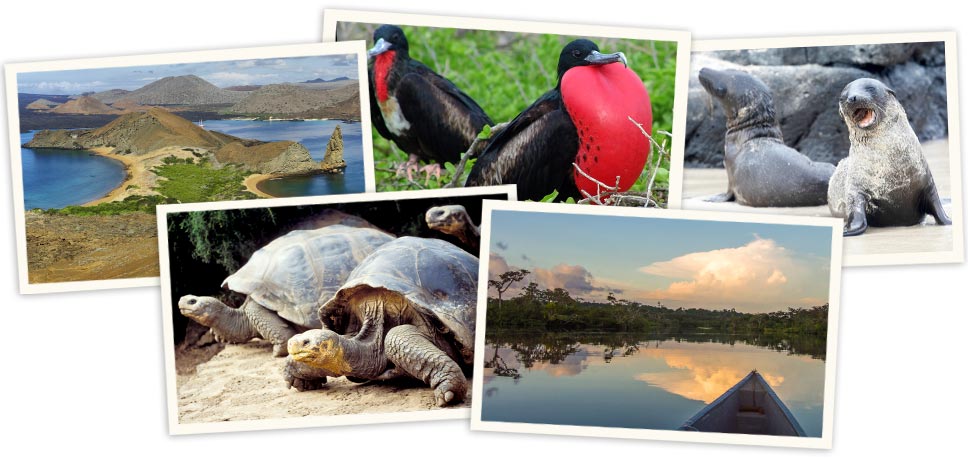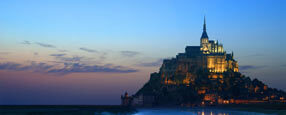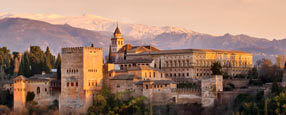ECUADOR & THE GALAPAGOS TOUR with York College
Featuring:
Cost from: 4875 USD
ITINERARY IN BRIEF
Welcome to one of the highest capitals in the world, sitting at just over 2750m / 9,022 ft above sea level. The city is nestled in a long, narrow valley of the Andes and flanked by the Pichincha Volcano to the west. At the southern end is the old town, focused on three large squares: the Plaza de la Independencia (also known as the Plaza Grande), Plaza San Francisco, and Plaza Santo Domingo. Quito's Old Town, a UNESCO World Heritage Site, is a magnificent showcase of colonial architecture.
Time-permitting this afternoon we will enjoy a brief tour of the colonial highlights of Quito including: the Presidential Palace, Independence Square and La Catedral.
Overnight in Quito.
Meals Included: Dinner
This morning we transfer to the airport and fly to Baltra Island, Galapagos. Here we are met and transferred over to the town of Puerto Ayora.
An archipelago of 12 large and several hundred smaller volcanic islands occupying a 4800 sq km (3,000 sq mile) area about 1000 km (620 miles) west of Ecuador, the Galapagos Islands have become one of the world's premier adventure travel destinations. Over the course of your visit, you'll enjoy up-close views of unusual, specially-adapted animals, plants and terrains including sea lions, tortoises, iguanas, land and sea birds, volcanic landscapes, unusual cacti and vegetation. Little has changed here since Charles Darwin's visit in 1835 to "this little world within itself" inspired his first theories of evolution. Nearly the entire archipelago is a natural sanctuary where you'll have thrilling encounters with some of the world's last completely untamed wildlife that has never learned to fear the presence of humans.
Later today we'll then take our first boat ride to the largest of the Galapagos Islands, Isabela. Much of Isabela's huge landmass is impassable, rife with fissures, blocked by jagged lava flows or tangled thickets and the rocky shore. The island is comprised of 6 volcanoes that have grown to become one island over time.
Hotel check-in and orientation walk around town.
Overnight on Isabela.
Meals Included: Breakfast, Lunch and Dinner
A full-day hiking* takes us up the magnificent Sierra Negra Volcano (Spanish: Black Mountain), a large shield volcano at the South eastern end of Isabela Island that rises to an altitude of 1124m / 3,688 ft. It coalesces with the volcanoes Cerro Azul to the west and Alcedo to the north. It is one of the most active of the Galapagos volcanoes with the most recent historic eruption in October 2005. While the southern and eastern side of the volcano is covered with lush tropical forest vegetation and fertile soil at moderate altitudes, the higher reaches are more barren with bushes and grasses of modest height of 23 meters. The northern side of the volcano is almost entirely devoid of vegetation (with the exception of some cacti) as it has been resurfaced in more recent times by lava flows.
Our tour will traverse the rim of the caldera along its east side before heading into the fresh lava fields north east of the main crater. Though we probably won't see any lava flowing, we will have the opportunity to explore thermal vents and other fascinating geologic features. The vistas are among the most breathtaking on Isabela and, on clear day, our route affords views of the northern volcanoes on Isabela and Fernandina.
* Hiking over uneven terrain and rocks, prolonged gradual inclined trails that can be alternatively very wet and slippery or dry and dusty. This is a 6+ hour hike in equatorial heat. If your physical fitness allows it, the view from the top is well worth the effort! You will need: hiking shoes with socks, water, hat, sunscreen.
Overnight on Isabela.
Meals Included: Breakfast, Lunch and Dinner
Today we visit the Breeding Center of the giant tortoise, the largest in Galapagos. In this strange land of strange animals, none is more iconic than Chelonoidis Nigra, known as galápago in Spanish. The place is literally named after them! Growing to over six feet long and eight hundred pounds, these are the biggest tortoises on the planet and one of the largest reptiles.
Later we make our way to the "Wall of Tears," constructed between the years of 1945 and 1959 by prisoners in the penal colony on the island, which had been established by President José María Velasco Ibarra in 1944, using infrastructure left by the US military after World War II. The wall is about 25 m (65 ft) tall and is said to have been the cause of thousands of deaths during its construction. Locals call it the wall of tears because it is said to emanate eerie cries.
Along the way we'll also visit some pink flamingos and stop at a lookout and one of the many natural pools, beaches, and mangrove swamps.
After lunch we have a Zodiac tour of the bay, where you can observe the only penguins found close to the equator, marine iguanas, and hopefully snorkel with marine turtles and an array of other marine life.
Overnight on Isabela.
Meals Included: Breakfast and Lunch
Today is an early morning departure to the Island of Santa Cruz, hopefully along the way observing dolphins and the waved albatross. The island supports all Galapagos vegetation zones, from cactus-strewn deserts around the coast, to tangled scalesia and miconia forests wreathed in cloud in the highlands, and sodden grassy pampas at the summit.
Later in the day we head to Tortuga Bay beach, famous for its expansive and pristine shoreline that gradually descends into the sparkling Pacific Ocean. It's a great place to try your hand at surfing or just relax and soak in the sun with the Marine Iguanas. A snorkel in the beautiful lagoons reveals the full richness of the Galapagos marine life. You can see colourful reef fish, white-tip sharks, rays and the beach's namesake, sea turtles. You should take time to walk through the Marine Iguana sanctuary where you might also catch a glimpse of Blue-Footed Boobies and Frigate birds along the shore.
Overnight in Puerto Ayora.
Meals Included: Breakfast, Lunch and Dinner
During our time in Puerto Ayora we will visit the Charles Darwin Research Station, staffed with international scientists conducting biological research and conservation projects. Here you can also admire giant tortoises, part of the breeding program. Travellers can also admire the impressive giant prickly-pear cactus forest and many land birds.
We will also visit the highlands of Santa Cruz, observing the Galapagos giant tortoise in natural surroundings and the amazing lava tunnels -- some over 1km long -- while taking in panoramic views of the islands.
Overnight Puerto Ayora.
Meals Included: Breakfast and Lunch
We depart by boat from Santa Cruz to San Cristobal Island. After lunch will we make our way to the top of San Cristobal through the settlement of El Progresso, to La Soledad from where we will have panoramic views out over the Pacific towards Santa Cruz, Floreana, and Santa Fe.
Later we have the opportunity to visit the Galapagos Science Center. There's a reason why many of the world's most famous scientists have visited the Galápagos Islands -- now it's your turn to discover one of the world's most beautiful and biologically diverse island locations. It's here that you will get hands-on experience studying topics such as biology, ecology, environmental studies, marine ecology, and sociology. This direct enrollment program is organized through the Galapagos Academic Institute for the Arts and Sciences (GAIAS), a remote campus of the Universidad San Francisco de Quito (USFQ).
Overnight on San Cristobal.
Meals Included: Breakfast, Lunch and Dinner
The day begins with a short boat to Kicker Rock, or Leon Dormido, a volcanic rock over140 m tall. It is called Kicker Rock as from one side it apparently looks like a gum boot who kicks something. Locals, on the other hand, look at it from the other side and see a sleeping lion -- a leon dormido. The monolithic rock formation is home to a number of tropical birds, blue-footed boobies and frigates, but the true appeal of this location occurs below the surface of the sea. The natural erosion of this ancient cone has created a channel between the rocks that provides the ideal habitat to view a variety of sharks and rays, including spotted eagle rays, white-tip reef sharks, the elusive Galapagos shark, and hammerheads.
Here we snorkel amidst an array of wildlife and then head to Manglacito, one of the most beautiful beaches in the islands, and return to port later in the afternoon.
Overnight on San Cristobal.
Meals Included: Breakfast, Lunch and Dinner
We bid farewell to the Galapagos with some free time in the morning or last minute souvenir shopping. We depart San Cristobal Island to return to Quito and get transferred to our hotel.
Overnight in Quito.
Meals Included: Breakfast and Dinner
This morning we catch our flight from Quito to Lago Agrio. We fly over the Andes to the frontier oil town of Lago Agrio where well be transferred to a small community for lunch. After lunch, the adventure begins with a motorized canoe ride along the Cuyabeno River to Laguna Grande. We keep our eyes peeled for wildlife along the way!
When Cuyabeno Lodge started operating in 1988, the owners believed that the rainforest traveller should be accommodated in conditions that would be both in harmony with the surrounding environment and attuned to the needs of the modern visitor. All of the lodge's installations and activities comply with strict procedures designed to conserve and protect the rainforest and to reduce the potential impact from tourism.
The Cuyabeno Reserve, primary rainforest, boasts an incredible variety of neo-tropical wildlife: river dolphins, tapirs, caimans, anacondas, monkeys, and the notorious piranha. The bird life is spectacular: the prehistoric-looking hoatzin, the umbrella bird, blue-headed parrot, the scarlet macaw, as well as the legendary harpy-eagle. There are still nearby communities of ancient indigenous tribes such as the Siona, the Secoya, and the Cofan who have lived in the Amazon basin for thousands of years.
After settling into our rooms at the lodge, we explore the lagoon by dug-out canoe to observe animals, take a swim in the lake, and enjoy the sunset from the canoe.
Overnight at Cuyabeno Lodge.
Meals Included: Breakfast, Lunch and Dinner
After breakfast, we walk through the "terra firma forest" with our naturalist guide who will explain the wildlife, medicinal forest plants, the forest ecosystem, and indigenous life. After lunch we have a trip in a dugout canoe to the flooded parts of the forest with macrolobium trees, covered with abundant epiphytes, to spot monkeys and birds.
This evening we have the opportunity to listen to the cacophony of sounds as we walk with our local guides and flashlights looking for insects, amphibians, and other nocturnal wildlife.
Overnight at Cuyabeno Lodge.
Meals Included: Breakfast, Lunch and Dinner
Today we have the unique opportunity to visit the Siona indigenous village, located downstream from the Cuyabeno Lodge, where we will we gain fascinating insight into the lives of the indigenous people in the area. Interacting with the locals, we learn about their daily lives and projects going on in the community. The Siona (also known as Sioni, Pioje, or Pioche-Sioni) are an indigenous ethnic group living in the Ecuadorian Amazon and in Colombia. They share territory along the Shushufindi, Aguarico, and Cuyabeno river with the Secoya people, with whom they are sometimes considered a single population. The Siona people are organized politically through the National Organization of Seona Indigenous People of Ecuador (ONISE).
After lunch you have the chance for a refreshing swim. Tonight we have an excursion by canoe to spot caiman, snakes, and nocturnal birds and bats.
Overnight at Cuyabeno Lodge.
Meals Included: Breakfast, Lunch and Dinner
After an early bird watching excursion, we bid farewell to Cuyabeno Reserve and make our way back to Quito. Upon arrival at the airport, we continue our journey north to Otavalo, home to South America's largest market.
In early years the Otavalo Valley was filled with farmers who raised crops in fertile lands where they lived. In the 14th century the Inca expansion reached north into the Otavalo area. The Caraquis who inhabited the area resisted the invaders. For 17 long years fierce fighting continued as the defiant Caraquis refused to be subjugated by the Incas. The Spanish arrived a few years after the Incas. They established a Hacienda system of workshops where Otavalenos were forced to work 15 hour days weaving fabrics.
Today this weaving tradition forms the basis of a lucrative industry that has allowed the Otavaleno indigenous peoples to join the world economy while retaining their traditional values and skills. During our time in the valley we will have a chance to visit with the local Otavalenos and see them working their craft. We visit a traditional home with adobe walls and visit with the owners who raise guinea pigs, a local delicacy.
Overnight in Otavalo.
Meals Included: Breakfast and Dinner
This morning we visit Otavalo to experience the market. This market is centered around 'Poncho Plaza'. All day long, the whir of cotton candy machines, Andean pipe music, and Quichua, the native tongue derived from the Incan tongue, drift across the square. A blinding maze of coloured textiles spills from the square across the town. Saturday is the main market day and you can find all the handicrafts that are made in Ecuador. You'll have time to wander both the handicraft stalls as well as the more traditional part of the market while trying out your bartering skills!
In the afternoon, we travel to the Equator Line Monument, known as the "middle of the world," where you can stand with one foot in the Northern and the other in the Southern Hemisphere. We also visit the excellent on-site ethnographic museum with exhibits pertaining to the many indigenous peoples of Ecuador.
Overnight in Quito.
Meals Included: Breakfast and Dinner
Early morning departure from Quito. BUEN VIAJE!
INCLUSIONS
- Triple/twin shared accommodation in clean and comfortable hotels and lodges.
- Breakfast daily and 10 lunches and 12 dinners per the itinerary.
- Sightseeing and entrance fees.
- Transportation in private vehicle.
- Services of local and naturalist guides.
- Services of a Global Educational Tour leader.
- Internal flights within your tour (to/from Galapagos, to/from Lago Agrio).
- International flights from Baltimore or Washington Dulles to/from Quito - pricing includes taxes and fuel surcharges**
EXCLUSIONS
- Tuition fees.
- Program fee for non-students.
- Trip Cancellation/Interruption and medical insurance.
- All personal expenses; e.g. laundry, drinking water, beverages.
- Gratuities to drivers, porters, waiters and gratuities to the Adventures Abroad tour leader will be collected before departure by Mr. Fyfe.
TOUR SAFETY
Global Educational Travel has implemented new safety measures and has received the World Travel and Tourism Council's Safe Travels stamp, which provides travellers with the assurance that we have adopted health and hygiene global standardised protocols – so you can experience 'Safe Travels'.
Click here for more info
LOOKING FOR INSPIRATION?








